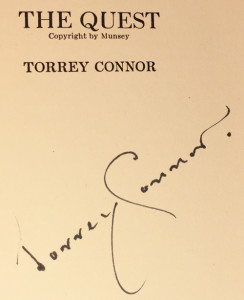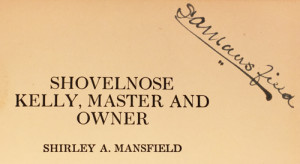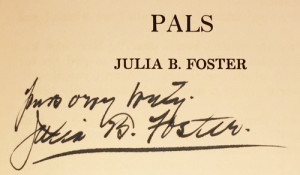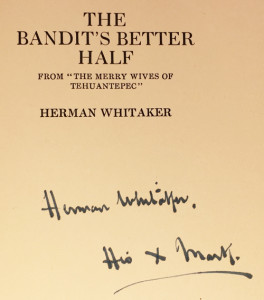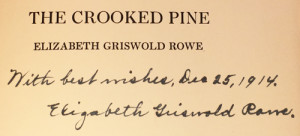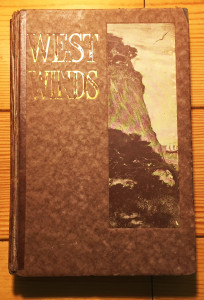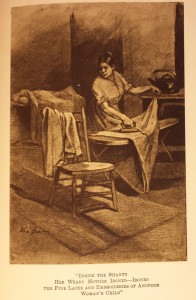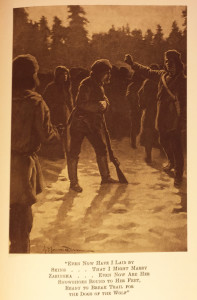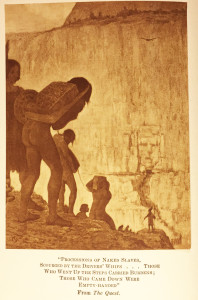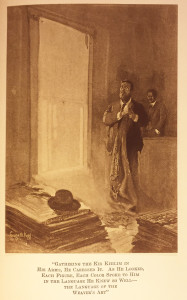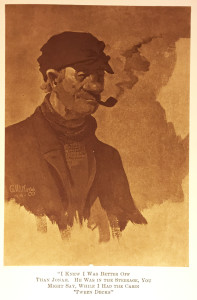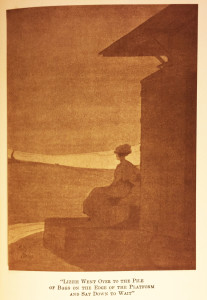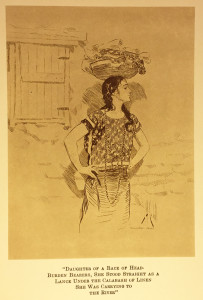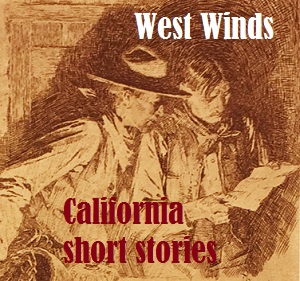
West Winds, 1914, book of short stories from California authors and illustrators.
I found the century old book West Winds at Mockingbird Used Books in Sebastopol, Ca. In addition to being printed in 1914, I was drawn to this book of California short stories because the illustrations were actually glued on to their respective pages and several of the authors signed their title page in the book. For $50 I figured I could own a little bit of literary and book publishing history of California.
West Winds California’s Book of Fiction, Written by California Authors and Illustrated by California Artists, Edited by Herman Whitaker, Paul Elder and Company Publishers, San Francisco. West Winds title page.
West Winds, a collection of California authors
The inside title page tells you almost everything you need to know about this hardbound book. Of the fifteen authors represented in the book I had only heard of Jack London. It’s interesting that ten of the fifteen authors are women. Several of the pieces don’t seem to have been originally written for the book but had been published in other sources. For example, Whitaker’s piece The Bandit’s Better Half is from his book The Merry Wives of Tehuantepec while other stories note a copyright date of 1899 to 1904.
Author autographs from 1914

Julia B. Foster autograph
As I flipped through the book I noticed that five authors had signed the introduction or title page to their short stories. Author, and the book’s editor, Herman Whitaker appended his autograph with “His X Mark”. Julia Foster penned a salutation above name that I can’t decipher. Elizabeth Rowe wrote, “With best wishes, Dec. 25, 1914.” The Christmas day date can lead one to speculate that this specific book was a gift to someone all the signatory authors had in common acquaintance. See images of the autographs at the end of the post.
Illustrations separately printed, glued into book

The Son of the Wolf illustrated by Maynard Dixon
I’m unsure if it was common practice to glue illustrations onto the pages of a book in 1914. But West Winds has such hand affixed illustrations printed on slightly heavier stock than the book pages itself. They are all of a sepia tone quality and they all seem to be either water color or pencil style. From what I can ascertain, all of the illustrators were floating around in the Bay Area and San Francisco at the time of the book’s publishing. Perhaps the best illustration is of Jack London’s Scruff Mackenzie as he negotiates, with rifle displayed, for the young Native Alaskan woman of the tribe to be his wife. See images of the illustrations at the end of the post.
History published in 1914
Regardless of when the pieces were written all locations are in the west from Mexico to Alaska. Most of the stories take place in California and several occur in San Francisco. There are a couple of ghost stories and two that focus on Native Americans. All of the stories give a historical glimpse of life at the turn of the 19th century which always piques my curiosity.
Entertaining short stories
Most of the short stories are good and a few are exceptional from my point of view. Jack London really knows how to create tension and anticipation in the most basic of situations. His short, The Son of the Wolf, embodies the machismo, manifest destiny, and arrogance of white American gold prospectors invading Native Alaskan land. Not only did the white men feel entitled to prospect for gold where they wanted to Alaska, some even thought that the Native Alaskan women were there’s for the taking as well.
Unknown authors got published
There is nothing ground breaking or earth shattering in the book either from the writing, illustrations or autographs. However, what could have been easily lost to time is Whitaker’s assembling of these California authors and artists into one collection. I can’t say these California authors have an entirely unique western voice, but they have described settings and life in their writing that adds to the historian’s understanding of life one hundred years ago.
Excerpts from the West Winds
“It was still early; the downtown cars were crowded with San Francisco’s workers on their way to office and store to take their parts in the drama of the city’s day. Walking briskly, Constance signaled a passing car and sprang aboard. The awkwardness of a few moments ago had vanished, giving her the perfect ease of one who feels herself on sure ground. A man moved aside and offered her his strap. “Kind of helps a little to hold to something steady,” he said, with the easy good-comradeship that she knew so well.” – The Corner Table, Rebecca N. Porter
“He was the dudiest little outfit ye ever see: had on a hat about as big as a two-bit piece, and a bald-faced shirt. He’d bought he sister out here for her health. She was a terrible sickly little girl; had eyes as big as my fist; and her face was plumb white. She orter been out here a year before she come, for even New Mexico can’t raise the dead. Ross bought the Lausen plan and fixed it up, and they lived there till she died. Their folks wanted him to bring her back East. But she had said she wanted to be buried under the big pine tree o’ the house, so he buried her there.” – The Greatest of These, Agnes Morley Cleaveland
“One day the old man was run over by the train on the curve near Chinatown. People thought he must have been too drunk with opium to get out of the way. I couldn’t’ help feeling a little relieved when I heard he was dead. He was buried in the Chinese cemetery on the last day of October. That night, Sammie was out with the boys for their Hallowe’en pranks. About midnight, when they were coming home, they passed the gate of the cemetery. You know it isn’t far very far from here.” – The Crooked Pine, Elizabeth Griswold Rowe
Then the negress thrust her roughly from her. Mrs. Hamilton groped after her.
“Mammy – Mammy,” she sobbed. “Where are you going?”
The gaunt old mother strode away as though she had not heard, then she turned, and in the clear darkness stretched her long, lean arms toward the heavens. “He’s mine!” she flung in defiance. “I’se gwine cut him down!” – The Mother, Sarah Thurston Nott
I most identified with Torrey Conner’s The Quest; a man in search of history and the place where it happened. An unexpected earthquake destroys the cave where slaves may have piled gold and opens the earth beneath the search party’s feet.
“Presently Williams sprang to his feet, and, seizing the Professor’s shoulder shook him roughly.
“It’s thar, Perfessor,” he shouted in the others’ inattentive ear. “Gold! Gold! Gold!-enough to make us all rich as kings! Don’t you sabe? The gold is thar.”
The Professor lifted a piteous face in wistful appeal to his companion.
“It was not to be, Williams, it w-was n-n-not to be. [] Williams, here it w-was that the S-seven Cities of Cibola once s-stood; and down there – d-down there in that cavern-are t-t-tablets graven with a people’s history. I have failed! I have failed!”
“It is the heat, no?” said the Mexican. “The senor is muy loco. No?” – The Quest, Torrey Conner
I’m not a professor, but I don’t have much use for gold either. Unlike the professor in The Quest, I did find the tablets, so to speak, graven with people’s history at that little bookstore in Sebastopol.
West Winds authors, illustrators and story brief
The Bandit’s Better Half, Herman Whitaker. Illustration by J.A. Cahill.
A Mexican bandit kidnaps a woman only to have her tame him into cobbling shoes for a living while she runs off for excitement.
Bufo, the Mascot, Elizabeth Abbey Everett
A pet horned toad helps a prospector avoid death by snake bite and find the gold he searches for.
Shovelnose Kelly, Master and Owner, Shirley A. Mansfield. Illustration by George W. Kegg .
A tall tale of told by an old mariner of man lost at sea only to survive in a belly of whale until he’s rescued.
The Mother, Sarah Thurston Nott
A black mother hears of her son’s lynching and leaves to cut him down and bury him.
The Greatest of These, Agnes Morley Cleaveland . Illustration by Will Crawford .
The story of three cowboys and how two of them must forgive the third for getting swindled out of their land and cattle.
The Corner Table, Rebecca N. Porter
A bored housewife returns to her newspaper roots to solve a bank robbery in San Francisco and stumble across a suicide.
Pals, Julia B. Foster. Illustration by Ruth Aikins.
A San Francisco woman tracks down her boyfriend in a dusty San Joaquin town and meets his new wife, who she knew back in the Mission District.
The Enchanted Mesa, Charles F. Lummis
A young Native American brave is left to care for elderly women as the men go off to plant the crops and the ensuing destruction from a massive storm on their stone abodes.
The Son of the Wolf, Jack London . Illustration by Maynard Dixon .
A gold miner in Alaska must convince a Native Alaskan tribe to let him leave with one of their prettiest daughters.
The Phantom Coach, Hester A. Dickinson
A ghost story of horse and coach that appear off the coast of Japan and is seen by the occupants of a steamer heading for California.
The Crooked Pine, Elizabeth Griswold Rowe
Another ghost story of a young man killed in a Chinese cemetery on Halloween night.
The Kis Khilim, Frances Orr Allen. Illustration by George W. Kegg.
An Armenian immigrant rug weaver and mender tries to persuade a wealthy family to part with one of their rugs he recognizes was woven by his late wife in their native country.
Jane Ann, a Ward of the State, Mrs. Carl Bank
A young orphan woman has a nervous breakdown under the pressure of never having her existence acknowledge at reformatory school.
The Temptation of Ann O’Brien, Harriet Holmes Haslett . Illustration by Alice Best
A laundress from Telegraph Hill in San Francisco tries to stretch her hard earned money while buying a suit for her dead son to be buried in and gets caught at the local department store.
The Quest, Torrey Connor. Illustration by Perham W. Nahl.
An obsessed professor finally locates the entrance to a long lost cavern of ancient people only to have it covered up by an earthquake.
Cover design and illustration by Perham W. Nahl.
Click images to enlarge
Autographs from West Winds authors
Illustrations from West Winds


